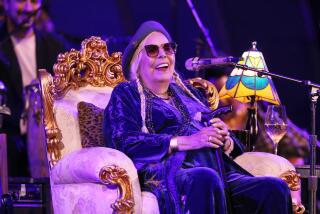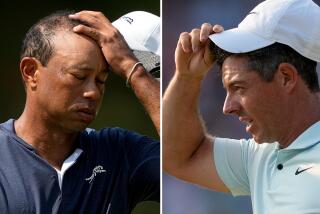Apple of Their Eyes
- Share via
Phil Mickelson is in a hurry. He’s burning up minutes on his cellphone on his way to a video news conference. He’s busy posing for a photo shoot for a sponsor. He’s practicing at the Callaway test center, launching golf balls toward a series of white towels that he has put down at increasing distances, seeing how close he can come to them.
How close he comes to another target, the U.S. Open at Winged Foot Golf Club, is golf’s most intriguing topic right now, and Mickelson is in a hurry to find out.
There are so many questions: Can Phil do it? Is Phil Tiger’s biggest worry? Is that really Phil?
As it turns out, that last question has been elevating the buzz factor as a sidelight to Mickelson’s dramatic run toward a third consecutive major title.
So the most compelling question may wind up as this: Who is Phil?
It’s not as simple as it sounds, and to peel open the Real Phil, this week’s U.S. Open may be a good place to start.
Is he the smiley-faced, grinning cap-tipper, or is that merely an act?
Begin with the Tiger Woods-Mickelson dynamic, portrayed in various circles as somewhere between slightly chilled and completely frozen over.
Certainly they were not reading from the same playbook at the 2004 Ryder Cup, where their on-course association was a disastrous pairing in a humiliating U.S. defeat at the hands of Europe.
And Woods was less than charmed when Mickelson said in a magazine article in 2003 that he was amazed Woods could play so well with so-called “inferior equipment.”
So Woods was no real fan of Mickelson and said so privately, but that was before Mickelson turned up his credibility factor by winning the last two majors -- the 2005 PGA Championship and the Masters in April. Two months ago at Augusta National, when Mickelson accepted his green jacket, he mentioned Woods’ gravely ill father, Earl, in his victory speech. Woods, obviously touched, tapped Mickelson’s leg and thanked him when Mickelson returned to sit down.
“I think we’re pretty good friends,” Mickelson said. “In fact, there’s not another individual I respect any more than Tiger Woods.”
One sports psychologist at UCLA, William Parham, suggested that like many athletes who are trying to get past a dominant rival, Mickelson had a mental block because of Woods’ success that he has since overcome.
“Phil really wasn’t playing golf, he was playing Tiger,” Parham said, “then the media played it all up and that added to it.”
Mickelson has effectively been playing to the fans for years. They love him in New York, where he established himself as the Man of the People at the 2002 U.S. Open at Bethpage Black. He didn’t win, he was second to Woods, but he did seem to win the popularity contest. He was the smiling, autograph-signing, knuckle-bumping underdog who never wins majors.
All that has changed now, after winning three of the last nine majors, and a New Phil has evolved. Is he the new and improved Phil, or are fans simply beginning to recognize who he has been all along?
Rob Mangini, who has known Mickelson since they were teammates at Arizona State, said Mickelson’s sunny disposition could be new to some, but not to him.
“Phil has always been a glass half-full guy, always full of possibilities,” Mangini said. “We’ve always thought, the guys who know him well, we’ve been totally waiting for him to play the way he’s playing the last couple years. He’s found himself at peace and he’s showing it.”
Mickelson said he’s not sure why his popularity appears to be soaring with golf fans.
“I’m probably not the person to ask,” he said, “but I will say, especially in New York, I’ve had such incredible experiences with the fans, at Bethpage Black, at Shinnecock and even last year, winning the PGA in New Jersey, that was amazing and I was treated so well.”
Mickelson seems to go out of his way to treat his fans well, an approach that some have questioned as insincere.
Vijay Singh is one who hinted that he considered Mickelson a phony. In an interview last year on “Real Sports With Bryant Gumbel,” Singh was asked to compare his image with that of Mickelson. Singh responded, “Is that the true Phil?”
Mickelson has some history with Singh. He had a run-in with Singh at the 2005 Masters after Singh asked rules officials to check the length of Mickelson’s spikes. On another occasion, Singh influenced PGA Tour officials to test Mickelson’s driver.
For his part, Mickelson was close-mouthed about Singh.
“That’s an area in which I just don’t know what to say,” Mickelson said.
But Mangini was not reluctant to offer his assessment.
“If you really want to go back, Vijay got caught cheating. Everybody knows that,” Mangini said of a 1985 incident in which Singh was accused of doctoring a scorecard on the Asian Tour. “Phil would never say that. But Vijay is in the same competitive group with Phil and I think it’s ticked Vijay off.”
From his observations following Mickelson on television, James Rosenberg, director of neuropsychiatry with a sports medicine institute in Marina del Rey, says Mickelson’s persona seems real enough.
“It’s so consistent, it’s just the way he is,” he said. “It would be tough to keep that front going if it wasn’t genuine.”
Rick Smith, who is Mickelson’s longtime swing coach, said he is always surprised at how gracious Mickelson is with fans who ask for his autograph at the wrong time, carefully pointing out he’d sign later if they want to wait. He said Mickelson doesn’t care if critics question his hugging his kids on television on the green, or kissing his wife, Amy, with the cameras rolling.
Rosenberg said Mickelson’s approach could not be more effective even if it were calculated.
“He is able to bring fans into the experience, treating the fans in an accepting way so they can take part,” he said. “What makes him really special is that the fan becomes more his peer than a spectator. He is humble and has a welcoming way about him.”
Smith said there should be no questions concerning Mickelson’s true nature.
“He really is who he is. He’s not fake,” Smith said. “He smiles and he looks at fans. A lot of guys on tour, their names aren’t necessary, they’re just linear ... they just go straight ahead, down the fairway. Phil looks around. Arnold Palmer did that, but Phil’s better at it than anyone I’ve seen.
“If any players are jealous of that, they had better look at themselves closely in the mirror.”
As for Mickelson, his on-course personality may be a personal evolution. Parham believes Mickelson has managed to eliminate some forms of self-protective behavior because of his success.
“He’s given himself permission to share a little more of himself -- with himself and his fan base.”
Dave Pelz, who works on Mickelson’s short game, said Mickelson is a much better, more complete player than ever before. And that, Pelz said, does wonders for a personality.
“He’s moved from being a really good player to a great player. He’s the challenger to Tiger and we can have some fun in golf.”
After winning the PGA and Masters, Mickelson is halfway to holding all four major titles at the same time, but he’s trying not to dwell on what could be called a “MickelSlam.”
“It’s hard enough to try to win one major, but to think about trying to win four is extremely overwhelming,” said Mickelson, who turns 36 the day of the second round of the Open. “I’m just trying to focus on Winged Foot, not on the third leg of the slam.”
When the Open starts Thursday in Mamaroneck, N.Y., Mickelson is pretty sure he will have put in the right amount of work, which includes three trips to the legendary layout that has been beefed up to 7,264 yards. That’s nearly 300 yards longer than it played at the 1997 PGA Championship and it features some daunting challenges.
Mickelson and everyone else can take their shots at a 640-yard par-five 12th hole and three par fours that measure at least 475 yards, including the 514-yard ninth.
But these are only numbers. Meanwhile, Mickelson is preparing himself for a run at another major championship, something that didn’t seem so probable until he broke through at the 2004 Masters, a victory that ended his 0-for-46 streak in majors.
His popularity has never been higher, but he says his success in golf hasn’t topped out.
“It’s been a lot of fun the last couple of years to win tournaments I dreamed about when I was a kid. I certainly don’t want it to be the apex, though; I want it to get better.
“It takes people years to learn how to play their best golf. It’s taken me a long time to get my best golf out. Nobody is going to win every week, but the enjoyment I get is being in contention.”
And if Mickelson has his way at Winged Foot, the same way he did at Baltusrol for the PGA and Augusta, chances are we’ll know a lot more about the Real Phil than ever before.
*
An Open book
Since ending his 0-for-46 drought in major championships by winning the 2004 Masters, Phil Mickelson has added the 2005 PGA Championship and the 2006 Masters to his resume. He has come close in the U.S. Open. Here are his top five performances at the Open:
*--* Finish Year Site Winner 2nd 2004 Shinnecock Hills Retief Goosen 2nd 2002 Bethpage Black Tiger Woods 2nd 1999 Pinehurst Payne Stewart T4th 1995 Shinnecock Hills Corey Pavin T7th 2001 Southern Hills Retief Goosen
*--*
More to Read
Go beyond the scoreboard
Get the latest on L.A.'s teams in the daily Sports Report newsletter.
You may occasionally receive promotional content from the Los Angeles Times.










